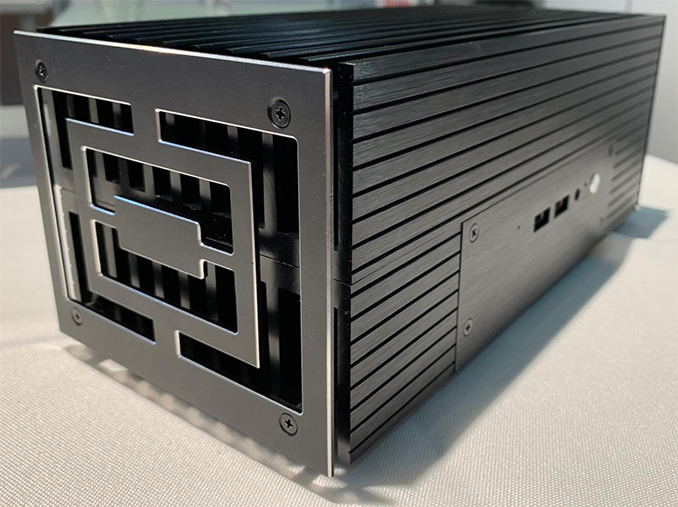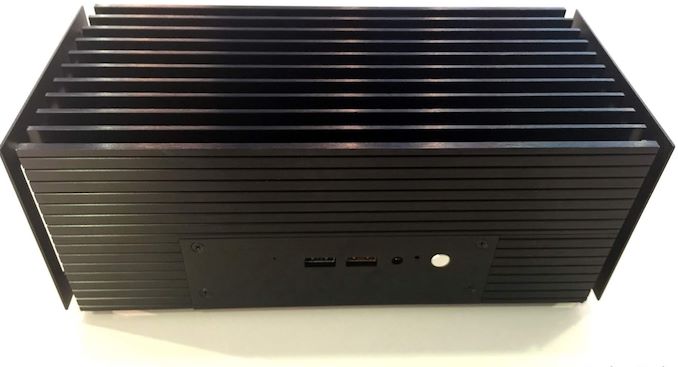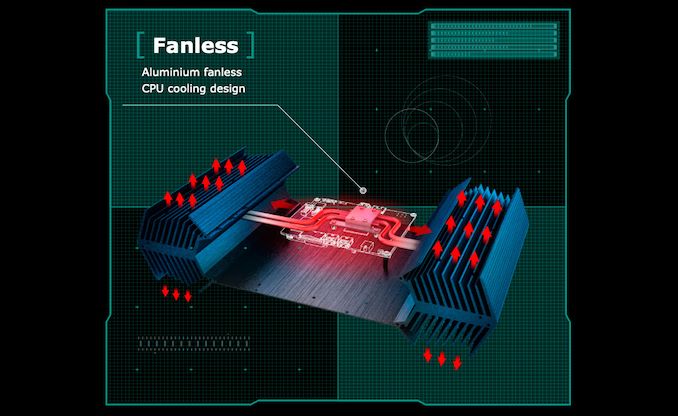Akasa's Turing: A Passively-Cooled Chassis for Intel’s Bean Canyon NUC
by Anton Shilov on February 8, 2019 3:00 PM EST- Posted in
- Desktop
- Cases/Cooling/PSUs
- Passive Cooling
- Chassis
- Cases
- Akasa

Akasa is prepping an aftermarket chassis for Intel’s 8th Gen "Bean Canyon: NUC systems. The Turing chassis will allow Intel’s NUC 8 ultra-compact form-factor (UCFF) computers to be converted to fanless systems, eliminating the noise that they produce.
Intel's Bean Canyon NUC systems are based on the company's 8th Gen Core i3/i5/i8 processors, which offer two or four cores as well as Iris Plus Graphics 655 (GT3e) iGPU. Theu are designed for users who need better graphics performance in a very compact form-factor. Apart from a 28 W CPU, Bean Canyon PCs also pack up to 32 GB of DDR4 memory, an M.2-2280 PCIe 3.0 x4 or SATA SSD, a 2.5-inch storage device, a Thunderbolt 3 controller to plug in an external graphics or storage sub-system, a 802.11ac Wi-Fi solution, and just about everything else that one comes to expect from an UCFF PC. Needless to say, the compact system packs a lot of heat, and as a result it uses a blower-based cooler in order to keep it in check
However Akasa has decided to do one better, and is putting together a chassis for Bean Canyon that allows the NUC to be converted into a passive, silent system.
Akasa is already known for its Galactico chassis (its scheme is depicted below) for Intel’s Skull Canyon NUC aimed at users seeking for UCFF gaming PCs. Based on the pictures of the Turing case published by FanlessTech, the upcoming chassis for Intel's Bean Canyon uses the same principle as its predecessor: it has a large CPU heat exchanger featuring multiple heat pipes that transfer heat from the processor to massive radiators. While the Galactico features two aluminum radiators located on the sides of the chassis, the Turing features an additional radiator above the CPU as well.
Quite naturally, Akasa’s Turing and Galactico chassis make Intel’s NUC systems considerably larger than they originally are, but they eliminate all the noises that these PCs produce. Furthermore, they retain all the I/O ports that the computers have, including GbE, USB Type-A/Type-C, TB3, HDMI, DP, audio, microSD, and even antennae fitting holes.
According to FanlessTech, Akasa will launch its Turing chassis shortly. Pricing is uknown, but it is likely that it will be comparable to a ~$200 MSRP of the Galactico.
Related Reading:
- Intel Officially Launches Bean Canyon NUCs with Coffee Lake-U Processors
- Intel’s Crimson Canyon NUCs with Cannon Lake CPU & Radeon dGPU Available for Pre-Order
- The Intel NUC8i7HVK (Hades Canyon) Review: Kaby Lake-G Benchmarked
- Intel NUC8i7HVK (Hades Canyon) Gaming Performance - A Second Look
- The Intel Skull Canyon NUC6i7KYK mini-PC Review
Source: FanlessTech













27 Comments
View All Comments
cfenton - Saturday, February 9, 2019 - link
That's fair. It fits nicely under my TV, so I don't need it to be any smaller. I guess you couldn't bolt it onto the back of a monitor like a NUC, though.ABR - Saturday, February 9, 2019 - link
"chassis make Intel’s NUC systems considerably larger than they originally are..." Yo, how about putting some dimensions in the article, or even ONE photo with something in the frame to compare it to?1_rick - Saturday, February 9, 2019 - link
Look at the last couple of pictures. You can see in each one a plate in the middle containing the I/O. That plate's roughly the size of the NUC itself.dontlistentome - Saturday, February 9, 2019 - link
Hopefully the additional size means this one might actually work.Got two of the previous ones (thin-itx and 7th gen NUC) and both are hopelessly inadequate when the CPUs are anything above middling.
I'm sure they work in the air-conditioned offices they test them in, but in a cool room in northern europe they get ridiculously hot when worked in anyway.
FreckledTrout - Saturday, February 9, 2019 - link
I think this is awesome. This would be fun to build for parents PC.dtomsen - Saturday, February 9, 2019 - link
@dontlistentomeActually, I have a Pentium G4600T running full throttle well below 60 °C iin a passive Akasa Euler TX case for Thin-Mini-ITX
And it sure looks nicer than this Bean Canyon monolith.
zmatt - Tuesday, February 12, 2019 - link
He did say "anything above middling". A Pentium is a low end chip. In the review "gaming" was tossed around. So I expect an i7 to work in this thing.dtomsen - Tuesday, February 12, 2019 - link
Yeah, you are right. Got his comment mixed up with one from another poster earlier about pentiums being too much for fanless cases from Akasa.My take: using more than peak 35w in a cpu/igpu is usually not wise in small and even medium fanless cases, gaming or not. Above that you need massive heatsinks and some form of vertical heat dissipation.
Maybe people are expecting too much and would be better of with a few well-placed, slow-moving and noise reduced fans for their gaming rigs.
Dusk_Star - Saturday, February 9, 2019 - link
'i3/i5/i8'Unless Intel's snuck in a new product line while I wasn't listening, I think that should probably be i7.
twotwotwo - Sunday, February 10, 2019 - link
With the new i9 and metal-themed Xeon naming scheme and everything else they're doing lately I honestly wondered for a sec if "i8" had become a thing, haha.